FREE SHIPPING when you spend $500+
Below $500: Flat rate of $9.99 for shipping.
Track Your OrderNeed Help? Call Us: 918-512-1281
- FOR THE DRIVER
- FOR THE PIT/SHOP
- FOR THE CAR
- GEAR & MERCH
Free shipping when you spend $500+
FREE SHIPPING when you spend $500+
Below $500: Flat rate of $9.99 for shipping.
Free shipping when you spend $500+
When it comes to head and neck restraint systems, we now have several options and manufacturers to choose from. As of this article there is the original HANS head and neck restraint and the Simpson hybrid system, but there are now head and neck restraint systems available from ZAMP with the Z-Tech Series 2A and the Z-Tech Series 6A, and models available from NecksGen and Schroth.
Although we we now have many options and different manufacturers to choose from, the overall design of head and neck restraints (HNR) remains basically the same. There are two major designs: the original being the HANS device which uses the chest to help absorb the energy of an impact and the Hybrid system or Hutchens device which uses the back to help spread out these forces.
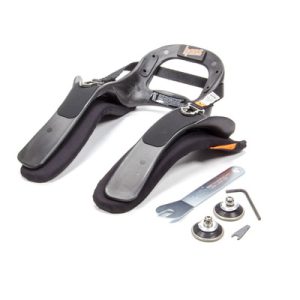
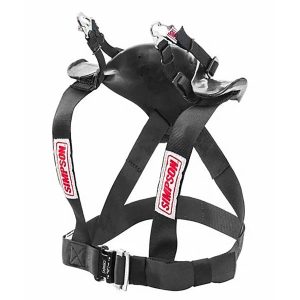
Any SFI 38.1 or FIA 8858 certified restraint system will help keep you safe at the track. The reason to use the head and extent system or (HNR) is to help prevent basilar spinal injuries.
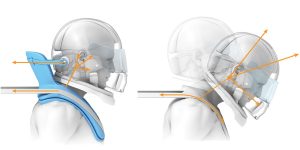
Basilar spinal injuries are where the body stays in place but the head moves forward at rapid rate detaching at the top of the spine. Not a fun topic to talk about for sure, but this is the injury that we are seeking to prevent with modern head and neck restraint systems. And unlike belts and helmets their certifications do not run out unless the device is involved in an on-track incident. But you may need to get them recertified every five years and this can be accomplished by contacting the manufacturer to understand their requirements. Some do it for free and some do it for a nominal fee. Check with your sanctioning body for their specific rules regarding recertification of head and neck strain systems. Since any head and neck restraint system certified by the SFI or FIA will help keep you safe at the track, for you, the driver the main considerations will be comfort, price and ease of use.
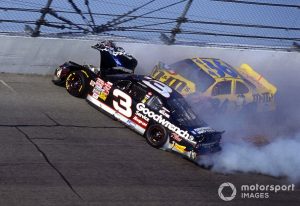
Although first offered for sale on a limited basis in 1991 it was the death of Dale Earnhardt (rest his soul) at the 2001 Daytona 500 that greatly escalated the sale and use of head and neck restraint systems as many sanctioning bodies began to make them mandatory. In the accident that took Dale’s life, Dale was only traveling 43 miles per hour when the impact occurred, but it was a 50g impact.
In 2002 the FIA develops the 8858 standard for FHR (frontal head restraints). The first to market was the HANS device and its overall design has remained relatively unchanged since it was introduced. The device is light, keeping weight out of the vehicle, and is comfortable to wear. The HANS device primarily uses the chest to help absorb the energy from a crash. Before your purchase be sure to visit CallToGrid.com to view the head and neck restraint systems we offer.
The Hybrid system, or Hutchens device, designed by Trevor Ashlline of Safety Solutions entered the market later in the 2000s. Simpson Performance Products acquired the hybrid line of head and neck strain systems when they purchased Safety Solutions in 2010. Unlike the HANS device which uses the chest to help absorb the energy of an impact, the hybrid device uses the back to help spread out these forces. The hybrid device has also been shown to protect better in side impacts and in incidents involving multiple impacts. And the hybrid system may be a good option for HPDE or Time Trials drivers since it is designed to provide protection with just an OEM three-point harness.
As of this content there are also devices from NecksGen, ZAMP Z-Tech, and Schroth. Early in the evolution of head and neck strain systems some devices only worked with two inch belts and even some three inch belts came with the upper section being two inches to accommodate the head and neck strain system. Today most head and neck restraint systems work with either a two inch or three inch harness system. Next is the choice of anchor system.
You can view the head and neck restraint systems by clicking the below link:
View our line of head and neck restraint systems.
Many come with the D-ring quick release system as shown in the image. By pulling down on the tether the connector will release from the anchor.
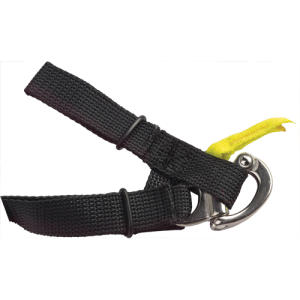
Newer on the market is the M6 or M61 quick release. The M61 was developed because many users felt the d-ring was too cumbersome to use. Caution though: if you have an FIA certified head and neck restraint you’ll need to make sure the M61 anchor comes with nut washers that are also FIA certified.
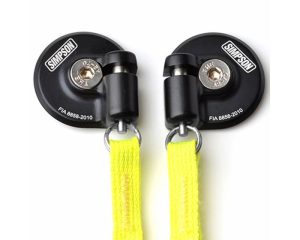
Post Anchor is the original anchor type and works with a spring-loaded clip that slides into place. A primary difference between the other two anchor systems is the post anchor system does not come with a quick release tether. The device is released by reaching back with your hands to disengage the spring-loaded clip.
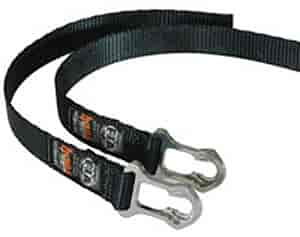
Before purchasing your HNR device the angle of your seat needs to be considered. From the image shown the angle of the collar should be about 60 to 90 degrees from the horizontal. For HANS the model of HANS needed is based upon seat angle. The Model 10 works for a 10 degree layback and the Model 20 works for a 20 degree layback and so on.
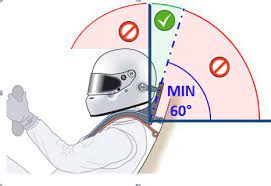
Most road racing seats have a 20 degree layback but check yours to be sure prior to your purchase.
If you wear a head and neck restraint but is not properly adjusted you’re not doing yourself any favors. You might as well not be wearing one at all. When wearing a head neck restraint you should feel restrained. This may take some getting used to.
My first track session wearing a properly adjusted head neck restraint I did feel restrained. I could not move my head as much side to side and had to use my mirrors more. This may take some getting used to.
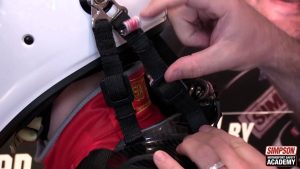
It is best to adjust the head and neck constraint in the car fully strapped down. Side to side you should not be able to move your helmet more than 20 degrees or so and you should hear a click with helmet movement indicating the limit has been reached. Pushing the head forward you should also hear a click indicating the limit is reached. If you feel restrained in the seat most likely the head and neck strain is properly adjusted. If you don’t feel restrained how full movement side to side most likely it is not properly adjusted.
Finally after purchasing your head and neck strain system and having it properly adjusted you’ll want to practice ingress and egress from the vehicle. I find it easier to put on the head and neck restraint attached to the helmet prior to entering the vehicle. This way if I need help I can request it. If I’m trying to do this inside the vehicle and gride time is approaching I may feel rushed and miss something. And it’s also harder to request help once inside the vehicle.
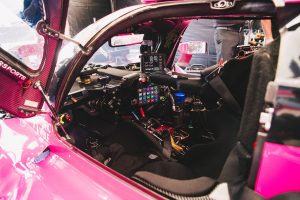
Practicing egress is one of the most critical things you can do!
This way you are prepared in a case where you had to exit the vehicle quickly. Most sanctioning bodies have a time to egress requirement. Years ago when I worked Tech for NASA we had a requirement that drivers be able to egress from the vehicle within 10 seconds. With the driver still fully strapped in we would Impound one vehicle at random just as they came off track. The driver had 10 seconds to exit the vehicle with the worst case scenario of the door being jammed shut. In your shop be sure to practice egress fully strapped in and wearing your head and neck restraint. Have someone time you. Another word of advice and overall good practice. When you come off track and park in your pit stall during a normal track day, try and store your equipment and exit the vehicle the same way each time. This way it becomes muscle memory. Doing it the same way each time you won’t need to think about it in a case where you had to exit quickly. For instance, detach steering wheel and stow, unstrap, make sure harnesses are out of the way, then exit.